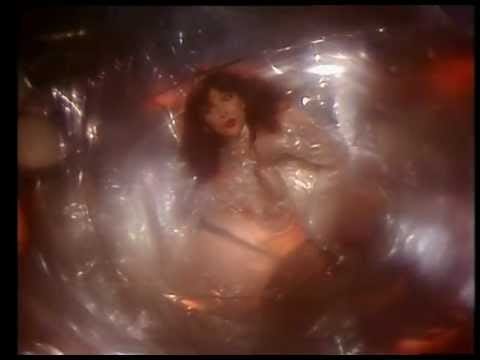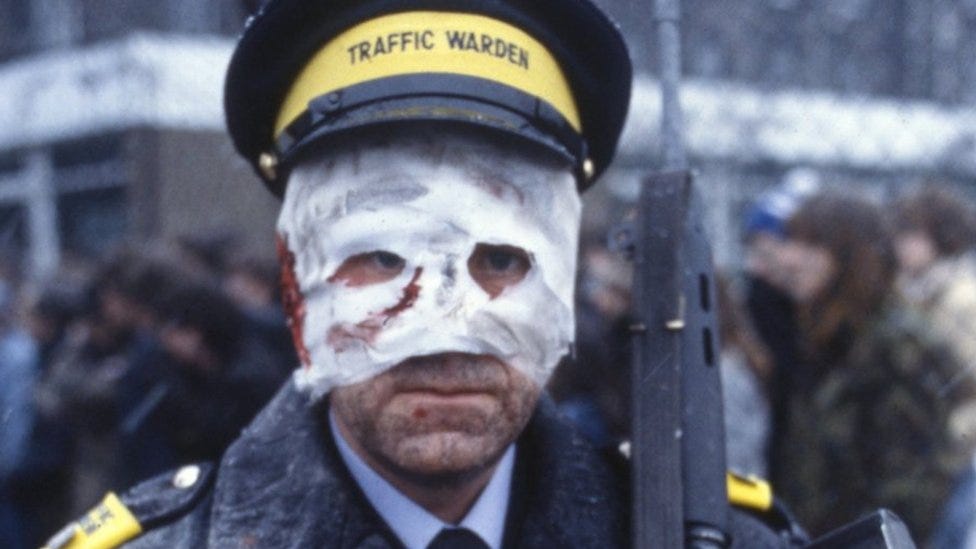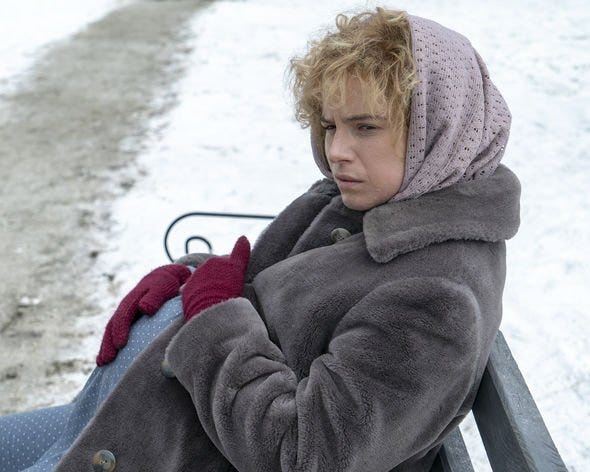Pregnancy and Nuclear Apocalypse – Breathing
Horror Moments, Kate Bush Edition
[Spoilers: Threads (1984), Chernobyl (2019)]
‘Horror Moments’ is a weekly series examining horror-inflected scenes and themes in unexpected places. The ‘moments’ are published weekly on Thursdays, and I share articles on the history of magic, theatre, storytelling, and more on Monday afternoons – don’t forget to subscribe! Catch up with the Kate Bush series here and the full back catalogue of horror moments (from Wallace & Gromit to Shakespeare) here.
The lead single from Kate Bush’s 1980 album Never For Ever was ‘Breathing,’ a song about nuclear war from the perspective of a foetus.
Throughout much of the song the music keeps a steady rhythmic pulse: the woman’s breathing, which underscores the narrator’s understanding of the world. Something outside is very wrong, but in here it still feels safe.
Outside
Gets inside, ooh-ooh-ooh
Through her skin
I've been out before, but this time it's much safer inLast night
In the sky, ooh-ooh-ooh
Such a bright light
My radar send me danger
But my instincts tell me to
Keep breathingOut, in, out, in, out, in
Breathing
Breathing my mother in
Breathing my beloved in
Breathing, breathing her nicotine
Breathing
Breathing the fall-out in, out in, out in, out in, out in
Like so many of Bush’s songs, there is poetry to be found in terrible things as the foetus begins to understand, albeit dimly, the horrors of this nuclear apocalypse. It notices, for example, how
Chips of plutonium are twinkling in every lung
The song never gives away exactly the woman’s location, nationality, or circumstances. We don’t know what conflict has led to this disaster. The baby’s supernatural sentience is limited, it speaks as if it has been born before and wants to re-enter the world but fears it has picked the wrong moment ‘I’ve been out before but this time it’s much safer in’. Where Bush’s Experiment IV stepped firmly into the realm of science fiction, this song is speculative dystopia: the horrors it reflects are real.
The 80s saw a number of fascinating cultural reactions to the threat of nuclear apocalypse. One of the most enduringly influential was Threads which came out in 1984, four years after ‘Breathing.’ Written by Barry Hines for the BBC, Threads speculated about what might happen to the northern English town of Sheffield should tensions between Russia and the US erupt into nuclear war. There are some interesting parallels between the film and Bush’s song which makes me wonder whether it was an influence, or whether Bush and Hines were simply both inspired by the same fearful zeitgeist.
Like ‘Breathing,’ the intention here was not necessarily to make a specific satirical comment about a particular political regime, but rather to reflect the human cost of any such disaster and the so-called ‘nuclear winter’ that would follow. Threads has been called one of the most harrowingly realistic depictions of what would happen if such a war broke out — and it’s a viewing experience unlike any other.
In Threads, the opening scenes of a young couple flirting and kissing are juxtaposed with flashes of news bulletins revealing the conflict which is about to transform their lives. Bush played the same trick in ‘Breathing’ where the climactic burst of agonising pleading ‘please give me something to breath’ is preceded by a clipped BBC voice explaining:
“The calling card of a nuclear bomb is the blinding flash that is far more dazzling than any light on earth --brighter even than the sun itself -- and it is by the duration of this flash that we are able to determine the size of the weapon… “
Bush’s brother John Carder Bush, a poet, wrote these lines in the style of an early warning government information film, the kind that starts appearing in the world of Threads, teaching you grim new skills like what to do with a dead body when it’s not safe to carry it outside.
Just like in ‘Breathing,’ unborn life in Threads comes to symbolise an uncertain future as our protagonists, Ruth and Jimmy, find out that Ruth is pregnant “it’s not the end of the world is it?” they wonder. Jimmy’s parents remind him that they could opt for an abortion, after all there’s a recession on, they’re young, and it’s a bad time to bring a baby into the world. They have no idea just how bad, in fact.
Ruth’s morning sickness in Threads foreshadows radiation poisoning, her body like her world is becoming a frightening and unfamiliar place. The mother figure in ‘Breathing’ soothes herself with cigarettes which enter the foetus’ bloodstream like the fall-out. Pregnancy and birth are the throughline of both stories.
Bush called ‘Breathing’ her ‘little symphony’ and it’s a layered and deeply tragic piece. It ends bleakly with the narrator screaming for life and breath as a chanting chorus audibly loses hope.
Oh, please
(What are we going to do without?)
Oh, let me breathe
(What are we going to do without?)
Quick, breathe in deep
(We are all going to die without)
Oh, leave me something to breathe
(What are we going to do without?)
Oh, leave me something to breathe
(We are all going to die without?)
Oh God, please leave us something to breathe
(What are we going to do without?)
Oh, life is
The last line of the song is left unfinished, the oxygen has been used up. Threads, likewise, ends with a stifled cry.
Bush was worried that ‘Breathing’ would be received poorly, in part because its message is so grim, but we can surely relate to the emotions that she gave voice to here:
I suddenly realised the whole devastation and disgusting arrogance of it all. Trying to destroy something that we’ve not created – the earth. The only thing we are is a breathing mechanism: everything is breathing. Without it we’re just nothing.
There’s something vitally important about disaster-fiction, this is horror as a vehicle for righteous indignation about the scale of human failings. Storytellers in this genre seem always to return to pregnancy, sometimes at the expense of real victims as was the case with the otherwise excellent 2019 miniseries Chernobyl which dramatized the 1986 disaster.
Lyudmila Ignatenko, the real wife of a firefighter who died of radiation poisoning, received abuse after the show aired because of its implication that she had cause her unborn daughter’s death by staying in the hospital with her husband in his final hours. The image of the dying man with peeling skin touching the swollen stomach proved too potent to resist, even though the child’s death is now thought to have been caused by a congenital heart defect and the baby would have been exposed to negligible levels of radiation.
When Athens hosed the Olympics in 2004, their majestic parade of Greek history at the opening ceremony ended with a pregnant woman whose stomach lit up. The symbolism was clear: here was the bright future of Greece.
In dystopian stories, pregnancy becomes a powerful symbol of future horrors not yet fully realised and the potential suffering of humans not yet born. ‘Breathing’ is one of the most succinct example of this kind of imagery, very much a product of the 80s, but timeless in its plea for peace— and it makes one hell of a song.
We’re nearing the end of our adventures in the horrors of Kate Bush. Next week, do you want to build a snowman? Okay, now do you want to let him into your bedroom? Until then, happy nightmare everyone!
Horror moments are posted every Thursday and a wide variety of articles exploring the history of magic, theatre, storytelling, and more are published on Monday afternoons.








If you're able to get to Kelvedon Hatch in Essex, it's well worth a trip. It's the bunker where the government was to repair to in the event of atomic war. Not only is going around it a surreal and chilling experience, there's a story that unfolds in the labels on the exhibits that finally lands with a level of existential horror that Lovecraft would have been proud of.
Oof, I've never seen Threads but your description reminded me of When the Wind Blows, which a quick Google search tells me came out just two years later. (I cried like a little baby watching that one...)
I really enjoy how you tie together different aspects of pop culture to get your point across. It's very interesting seeing the common anxieties and leitmotifs that we share as a society.